Tributyltin Alters Seric Bile Acid Pool Composition in Male Rats
Abstract
1. Introduction
2. Materials and Methods
2.1. Reagents
2.2. Animals and Treatment
2.3. Preparation of Serum and Tissue Isolation
2.4. Histopathological Analysis
2.5. Serum Biochemistry
2.6. Analysis of Serum BAs
2.7. Statistical Analysis
3. Results
3.1. Effects of TBT Exposure on Systemic Toxicity and Lipid Metabolism in Rats
3.2. Effects of TBT Exposure on the Liver in Rats
3.3. Effects of TBT on Serum BAs
3.4. The Results of Differences in BA Analysis Between Groups
4. Discussion
5. Conclusions
Supplementary Materials
Author Contributions
Funding
Institutional Review Board Statement
Informed Consent Statement
Data Availability Statement
Conflicts of Interest
References
- Antizar-Ladislao, B. Environmental levels, toxicity and human exposure to tributyltin (TBT)-contaminated marine environment. Environ. Int. 2008, 34, 292–308. [Google Scholar] [CrossRef] [PubMed]
- Burton, E.D.; Phillips, I.R.; Hawker, D.W. Sorption and desorption behavior of tributyltin with natural sediments. Environ. Sci. Technol. 2004, 38, 6694–6700. [Google Scholar] [CrossRef]
- Beyer, J.; Song, Y.; Tollefsen, K.E.; Berge, J.A.; Tveiten, L.; Helland, A.; Øxnevad, S.; Schøyen, M. The ecotoxicology of marine tributyltin (TBT) hotspots: A review. Mar. Environ. Res. 2022, 179, 105689. [Google Scholar] [CrossRef] [PubMed]
- Tang, L.; Zhang, Y.-H.; Wang, X.; Zhang, C.-C.; Qin, G.; Lin, Q. Effects of chronic exposure to environmental levels of tributyltin on the lined seahorse (Hippocampus erectus) liver: Analysis of bioaccumulation, antioxidant defense, and immune gene expression. Sci. Total Environ. 2021, 801, 149646. [Google Scholar] [CrossRef]
- Ip, J.C.-H.; Leung, P.T.Y.; Ho, K.K.Y.; Qiu, J.-W.; Leung, K.M.Y. Transcriptomic analysis reveals the endocrine toxicity of tributyltin and triphenyltin on the whelk Reishia clavigera and mechanisms of imposex formation. Environ. Int. 2024, 190, 108867. [Google Scholar]
- Sadighara, P.; Jahanbakhsh, M.; Nazari, Z.; Mostashari, P. The organotin contaminants in food: Sources and methods for detection: A systematic review and meta-analysis. Food Chem. X 2021, 12, 100154. [Google Scholar] [CrossRef] [PubMed]
- Takahashi, S.; Mukai, H.; Tanabe, S.; Sakayama, K.; Miyazaki, T.; Masuno, H. Butyltin residues in livers of humans and wild terrestrial mammals and in plastic products. Environ. Pollut. 1999, 106, 213–218. [Google Scholar] [CrossRef]
- Zamora, Z.; Wang, S.; Chen, Y.-W.; Diamante, G.; Yang, X. Systematic transcriptome-wide meta-analysis across endocrine disrupting chemicals reveals shared and unique liver pathways, gene networks, and disease associations. Environ. Int. 2024, 183, 108339. [Google Scholar] [CrossRef]
- Dauwe, Y.; Mary, L.; Oliviero, F.; Dubois, L.; Rousseau-Bacquie, E.; Gomez, J.; Gayrard, V.; Mselli-Lakhal, L. Synergistic steatosis induction in mice: Exploring the interactions and underlying mechanisms between PFOA and tributyltin. Cells 2024, 13, 940. [Google Scholar] [CrossRef]
- Huang, C.-F.; Yang, C.-Y.; Tsai, J.-R.; Wu, C.-T.; Liu, S.-H.; Lan, K.-C. Low-dose tributyltin exposure induces an oxidative stress-triggered JNK-related pancreatic β-cell apoptosis and a reversible hypoinsulinemic hyperglycemia in mice. Sci. Rep. 2018, 8, 5734. [Google Scholar] [CrossRef]
- Yan, H.; Guo, H.; Cheng, D.; Kou, R.; Zhang, C.; Si, J. Tributyltin reduces the levels of serum adiponectin and activity of AKT and induces metabolic syndrome in male mice. Environ. Toxicol. 2018, 33, 752–758. [Google Scholar] [CrossRef] [PubMed]
- Zhan, J.; Ma, X.; Liu, D.; Liang, Y.; Li, P.; Cui, J.; Zhou, Z.; Wang, P. Gut microbiome alterations induced by tributyltin exposure are associated with increased body weight, impaired glucose and insulin homeostasis and endocrine disruption in mice. Environ. Pollut. 2020, 266, 115276. [Google Scholar] [CrossRef] [PubMed]
- Ridlon, J.M.; Gaskins, H.R. Another renaissance for bile acid gastrointestinal microbiology. Nat. Rev. Gastroenterol. Hepatol. 2024, 21, 348–364. [Google Scholar] [CrossRef]
- Fuchs, C.D.; Simbrunner, B.; Baumgartner, M.; Campbell, C.; Reiberger, T.; Trauner, M. Bile acid metabolism and signalling in liver disease. J. Hepatol. 2025, 82, 134–153. [Google Scholar] [CrossRef] [PubMed]
- Stellaard, F.; Lütjohann, D. Dynamics of the enterohepatic circulation of bile acids in healthy humans. Am. J. Physiol. Gastrointest. Liver Physiol. 2021, 321, G55–G66. [Google Scholar] [CrossRef]
- Vos, J.G.; De Klerk, A.; Krajnc, E.I.; Van Loveren, H.; Rozing, J. Immunotoxicity of bis(tri-n-butyltin)oxide in the rat: Effects on thymus-dependent immunity and on nonspecific resistance following long-term exposure in young versus aged rats. Toxicol. Appl. Pharmacol. 1990, 105, 144–155. [Google Scholar] [CrossRef]
- García-Cañaveras, J.C.; Donato, M.T.; Castell, J.V.; Lahoz, A. Targeted profiling of circulating and hepatic bile acids in human, mouse, and rat using a UPLC-MRM-MS-validated method. J. Lipid Res. 2012, 53, 2231–2241. [Google Scholar] [CrossRef]
- Merlo, E.; Zimerman, J.; dos Santos, F.C.F.; de Oliveira, J.F.Z.; da Costa, C.S.; Carneiro, P.H.; Miranda-Alves, L.; Warner, G.R.; Graceli, J.B. Subacute and low dose of tributyltin exposure leads to brown adipose abnormalities in male rats. Toxicol. Lett. 2023, 376, 26–38. [Google Scholar] [CrossRef]
- Bertuloso, B.D.; Podratz, P.L.; Merlo, E.; de Araújo, J.F.P.; Lima, L.C.F.; de Miguel, E.C.; de Souza, L.N.; Gava, A.L.; de Oliveira, M.; Miranda-Alves, L.; et al. Tributyltin chloride leads to adiposity and impairs metabolic functions in the rat liver and pancreas. Toxicol. Lett. 2015, 235, 45–59. [Google Scholar] [CrossRef]
- Collins, S.L.; Stine, J.G.; Bisanz, J.E.; Okafor, C.D.; Patterson, A.D. Bile acids and the gut microbiota: Metabolic interactions and impacts on disease. Nat. Rev. Microbiol. 2023, 21, 236–247. [Google Scholar] [CrossRef]
- Perino, A.; Schoonjans, K. Metabolic Messengers: Bile acids. Nat. Metab. 2022, 4, 416–423. [Google Scholar] [CrossRef] [PubMed]
- Jia, W.; Xie, G.; Jia, W. Bile acid-microbiota crosstalk in gastrointestinal inflammation and carcinogenesis. Nat. Rev. Gastroenterol. Hepatol. 2018, 15, 111–128. [Google Scholar] [CrossRef]
- Kubitz, R.; Dröge, C.; Kluge, S.; Stross, C.; Walter, N.; Keitel, V.; Häussinger, D.; Stindt, J. Autoimmune BSEP Disease: Disease Recurrence After Liver Transplantation for Progressive Familial Intrahepatic Cholestasis. Clin. Rev. Allergy Immunol. 2015, 48, 273–284. [Google Scholar] [CrossRef]
- Stieger, B.; Meier, Y.; Meier, P.J. The bile salt export pump. Pflugers Arch. Eur. J. Physiol. 2006, 453, 611–620. [Google Scholar] [CrossRef] [PubMed]
- Guo, H.; Yan, H.; Cheng, D.; Wei, X.; Kou, R.; Si, J. Tributyltin exposure induces gut microbiome dysbiosis with increased body weight gain and dyslipidemia in mice. Environ. Toxicol. Pharmacol. 2018, 60, 202–208. [Google Scholar] [CrossRef]
- Jiang, P.; Yuan, G.-h.; Jiang, B.-r.; Zhang, J.-y.; Wang, Y.-q.; Lv, H.-j.; Zhang, Z.; Wu, J.-l.; Wu, Q.; Li, L. Effects of microplastics (MPs) and tributyltin (TBT) alone and in combination on bile acids and gut microbiota crosstalk in mice. Ecotoxicol. Environ. Saf. 2021, 220, 112345. [Google Scholar] [CrossRef]
- Singh, P.; Gollapalli, K.; Mangiola, S.; Schranner, D.; Yusuf, M.A.; Chamoli, M.; Shi, S.L.; Bastos, B.L.; Nair, T.; Riermeier, A.; et al. Taurine deficiency as a driver of aging. Science 2023, 380, eabn9257. [Google Scholar] [CrossRef] [PubMed]
- Baker, A.H.; Wu, T.H.; Bolt, A.M.; Gerstenfeld, L.C.; Mann, K.K.; Schlezinger, J.J. From the Cover: Tributyltin Alters the Bone Marrow Microenvironment and Suppresses B Cell Development. Toxicol. Sci. 2017, 158, 63–75. [Google Scholar] [CrossRef]
- Da Silva, R.C.; Teixeira, M.P.; de Paiva, L.S.; Miranda-Alves, L. Environmental health and toxicology: Immunomodulation promoted by endocrine-disrupting chemical tributyltin. Toxics 2023, 11, 696. [Google Scholar] [CrossRef]
- Katz, T.A.; Grimm, S.L.; Kaushal, A.; Dong, J.; Treviño, L.S.; Jangid, R.K.; Gaitán, A.V.; Bertocchio, J.-P.; Guan, Y.; Robertson, M.J.; et al. Hepatic tumor formation in adult mice developmentally exposed to organotin. Environ. Health Perspect. 2020, 128, 017010. [Google Scholar] [CrossRef]
- Yao, W.; Wei, X.; Guo, H.; Cheng, D.; Li, H.; Sun, L.; Wang, S.; Guo, D.; Yang, Y.; Si, J. Tributyltin reduces bone mineral density by reprograming bone marrow mesenchymal stem cells in rat. Environ. Toxicol. Pharmacol. 2020, 73, 103271. [Google Scholar] [CrossRef] [PubMed]
- Watanabe, M.; Houten, S.M.; Mataki, C.; Christoffolete, M.A.; Kim, B.W.; Sato, H.; Messaddeq, N.; Harney, J.W.; Ezaki, O.; Kodama, T.; et al. Bile acids induce energy expenditure by promoting intracellular thyroid hormone activation. Nature 2006, 439, 484–489. [Google Scholar] [CrossRef] [PubMed]
- Adeeko, A.; Li, D.; Forsyth, D.S.; Casey, V.; Cooke, G.M.; Barthelemy, J.; Cyr, D.G.; Trasler, J.M.; Robaire, B.; Hales, B.F. Effects of in utero tributyltin chloride exposure in the rat on pregnancy outcome. Toxicol. Sci. 2003, 74, 407–415. [Google Scholar] [CrossRef] [PubMed]
- Andrade, M.N.; Santos-Silva, A.P.; Rodrigues-Pereira, P.; Paiva-Melo, F.D.; de Lima Junior, N.C.; Teixeira, M.P.; Soares, P.; Dias, G.R.M.; Graceli, J.B.; de Carvalho, D.P.; et al. The environmental contaminant tributyltin leads to abnormalities in different levels of the hypothalamus-pituitary-thyroid axis in female rats. Environ. Pollut. 2018, 241, 636–645. [Google Scholar] [CrossRef]
- Miranda, R.A.; Lima, D.G.V.; de Souza, L.L.; Souza da Silva, B.; Bertasso, I.M.; Meyer, L.G.; Rossetti, C.L.; Junior, R.R.; Miranda-Alves, L.; de Moura, E.G.; et al. Maternal exposure to tributyltin alters the breast milk, hormonal profile, and thyroid morphology of dams and induces sex-specific changes in neonate rat offspring. Environ. Pollut. 2024, 349, 123963. [Google Scholar] [CrossRef]
- Wang, J.; Hallinger, D.R.; Murr, A.S.; Buckalew, A.R.; Lougee, R.R.; Richard, A.M.; Laws, S.C.; Stoker, T.E. High-throughput screening and chemotype-enrichment analysis of ToxCast phase II chemicals evaluated for human sodium-iodide symporter (NIS) inhibition. Environ. Int. 2019, 126, 377–386. [Google Scholar] [CrossRef]
- Li, P.; Li, Z.-H. Environmental co-exposure to TBT and cd caused neurotoxicity and thyroid endocrine disruption in zebrafish, a three-generation study in a simulated environment. Environ. Pollut. 2020, 259, 113868. [Google Scholar] [CrossRef]
- Li, Z.-H.; Li, P. Effects of the tributyltin on the blood parameters, immune responses and thyroid hormone system in zebrafish. Environ. Pollut. 2021, 268, 115707. [Google Scholar] [CrossRef]
- Bianco, A.C.; Salvatore, D.; Gereben, B.; Berry, M.J.; Larsen, P.R. Biochemistry, cellular and molecular biology, and physiological roles of the iodothyronine selenodeiodinases. Endocr. Rev. 2002, 23, 38–89. [Google Scholar] [CrossRef]
- Yang, F.; Mao, C.; Guo, L.; Lin, J.; Ming, Q.; Xiao, P.; Wu, X.; Shen, Q.; Guo, S.; Shen, D.-D.; et al. Structural basis of GPBAR activation and bile acid recognition. Nature 2020, 587, 499–504. [Google Scholar] [CrossRef]
- Talavera Andújar, B.; Mary, A.; Venegas, C.; Cheng, T.; Zaslavsky, L.; Bolton, E.E.; Heneka, M.T.; Schymanski, E.L. Can Small Molecules Provide Clues on Disease Progression in Cerebrospinal Fluid from Mild Cognitive Impairment and Alzheimer’s Disease Patients? Environ. Sci. Technol. 2024, 58, 4181–4192. [Google Scholar] [CrossRef] [PubMed]
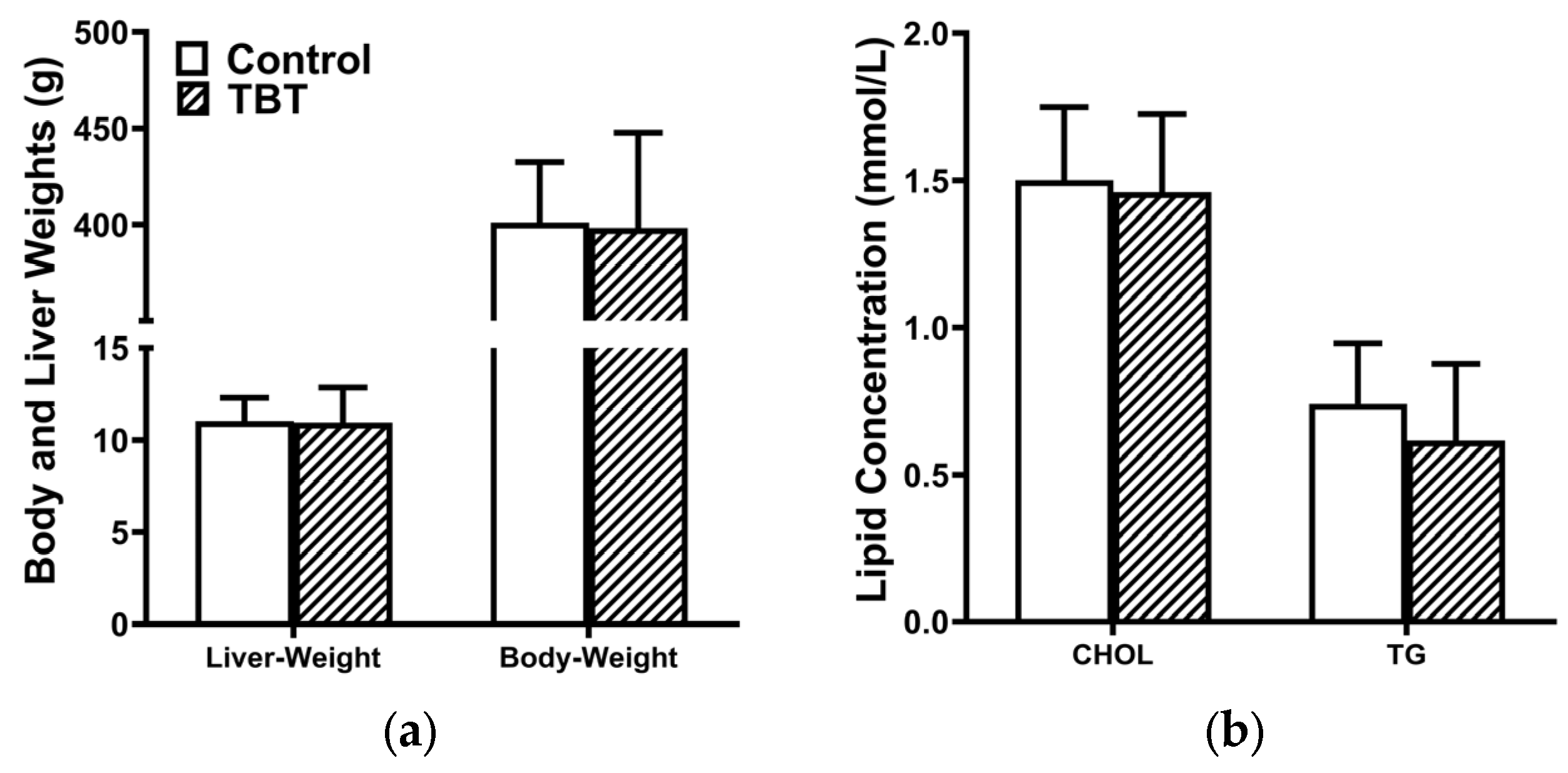
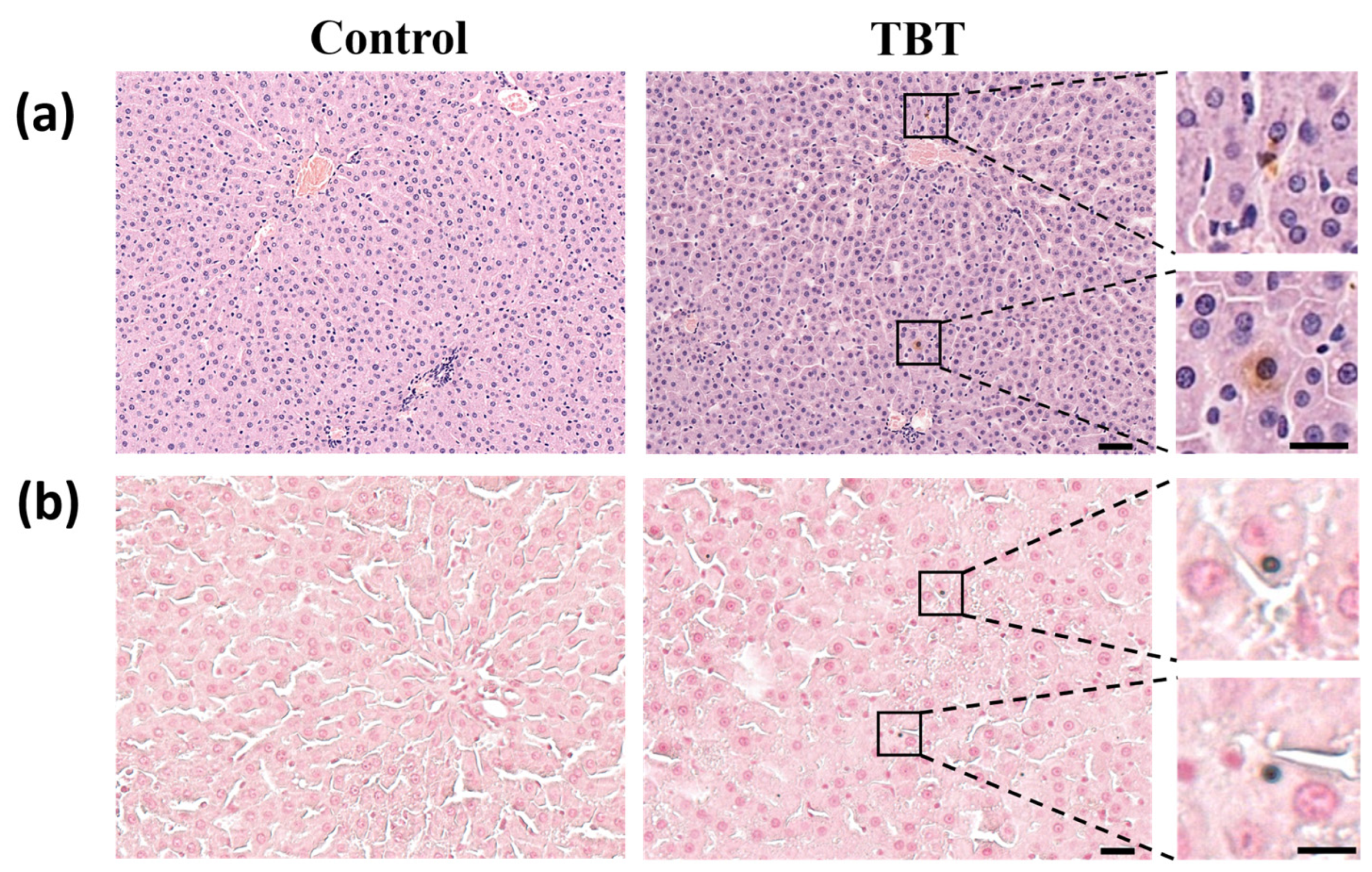
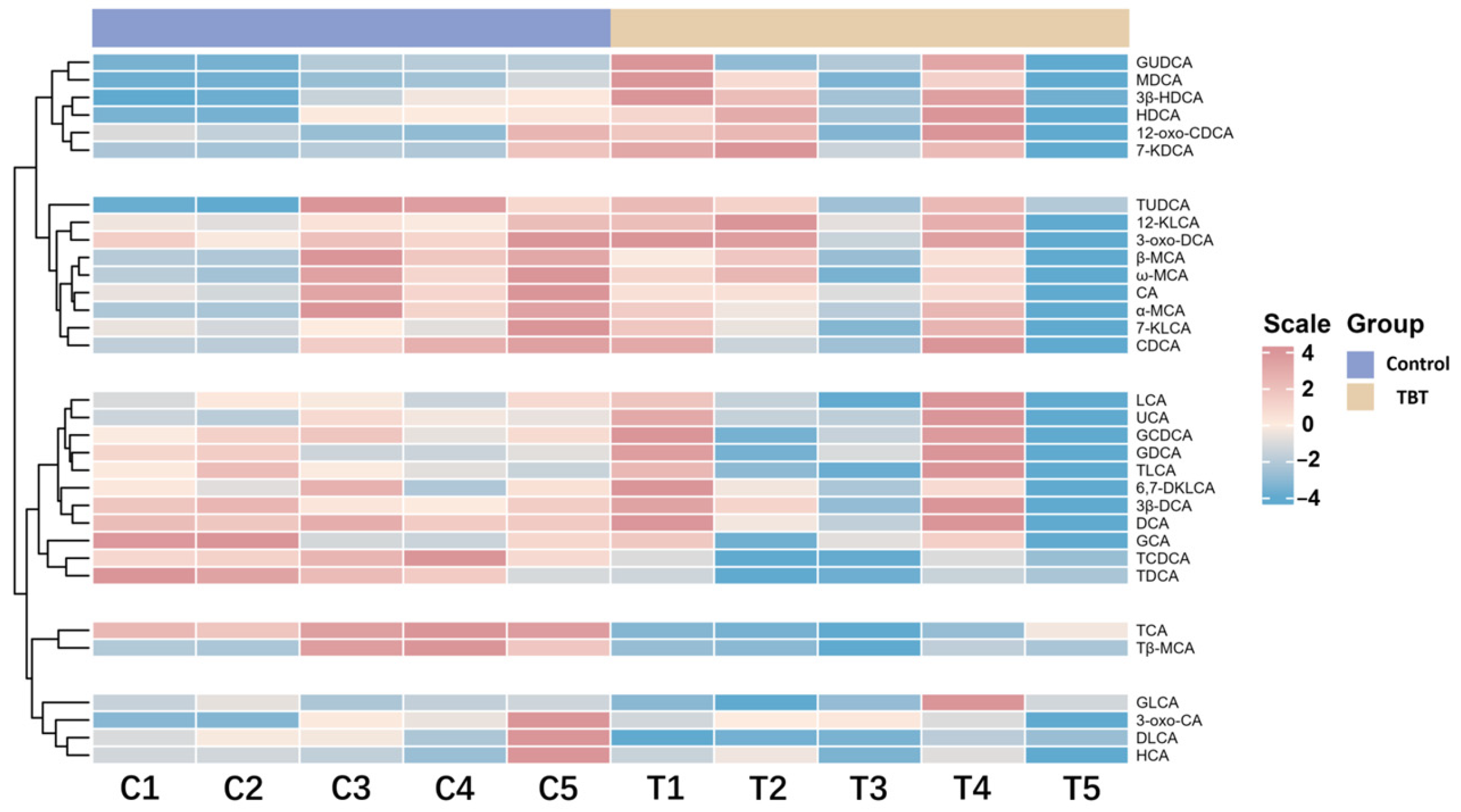
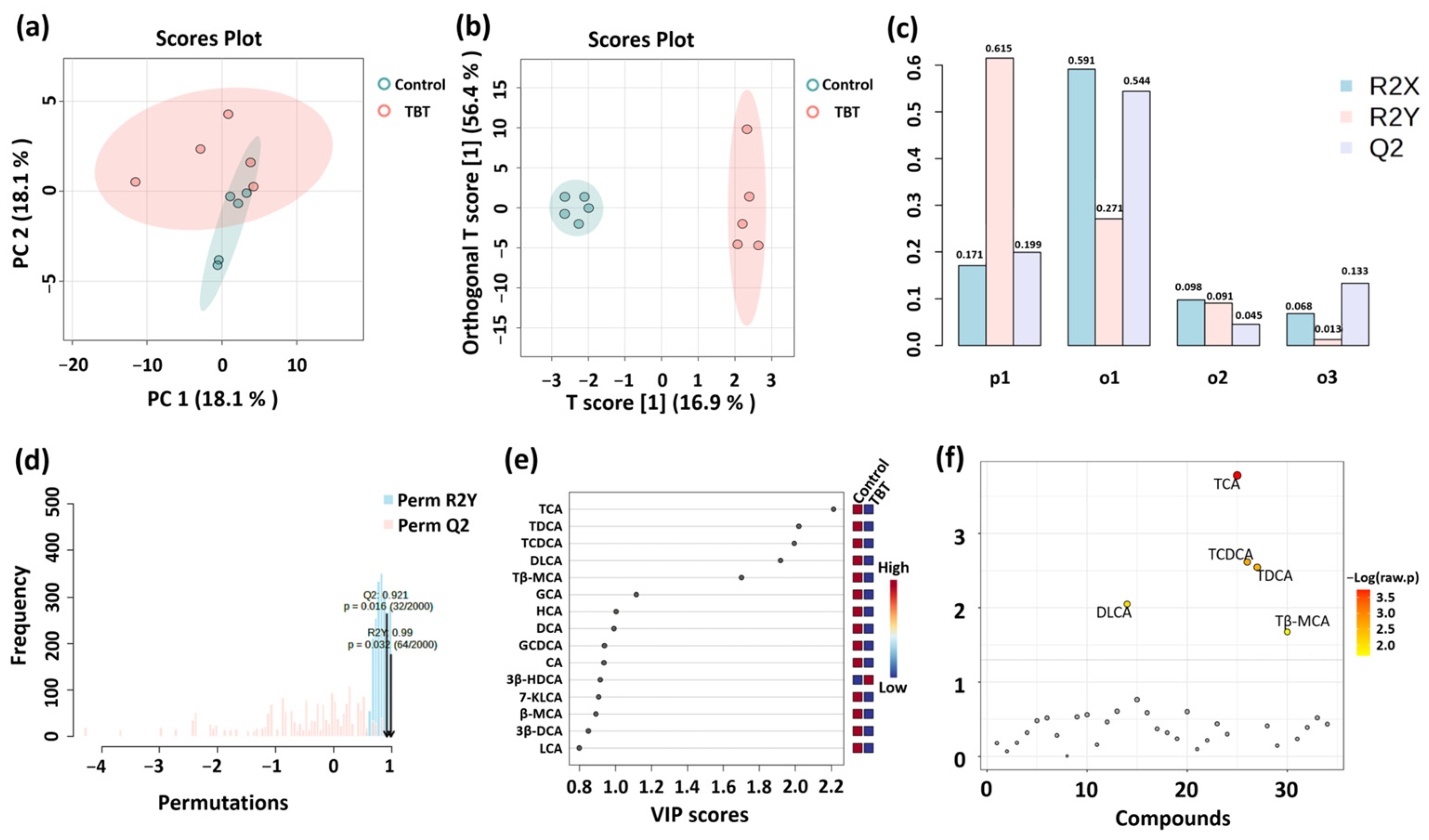
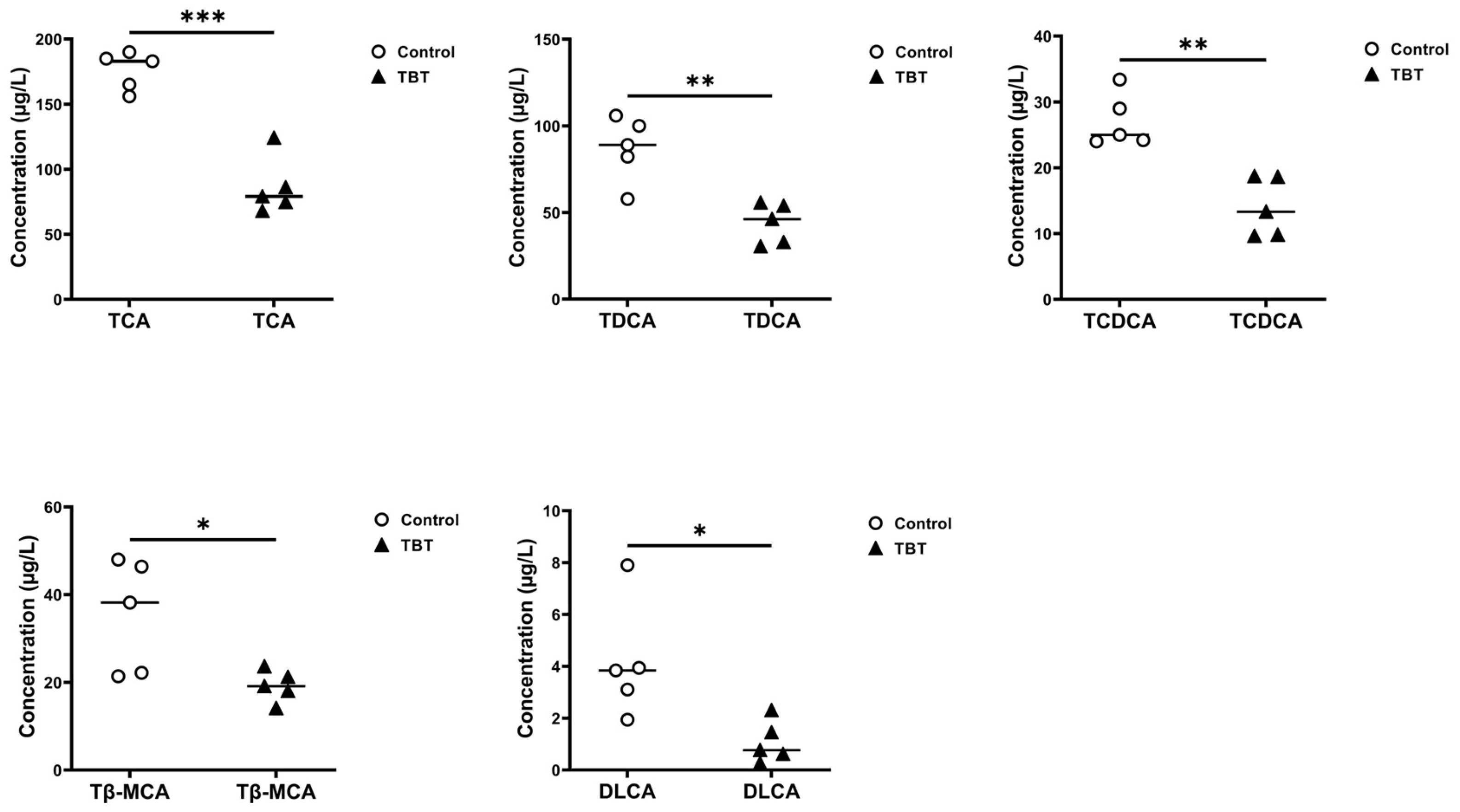
Disclaimer/Publisher’s Note: The statements, opinions and data contained in all publications are solely those of the individual author(s) and contributor(s) and not of MDPI and/or the editor(s). MDPI and/or the editor(s) disclaim responsibility for any injury to people or property resulting from any ideas, methods, instructions or products referred to in the content. |
© 2025 by the authors. Licensee MDPI, Basel, Switzerland. This article is an open access article distributed under the terms and conditions of the Creative Commons Attribution (CC BY) license (https://creativecommons.org/licenses/by/4.0/).
Share and Cite
Yao, W.; Luan, J.; Li, H.; Cheng, D.; Lv, S.; Si, J. Tributyltin Alters Seric Bile Acid Pool Composition in Male Rats. Toxics 2025, 13, 440. https://doi.org/10.3390/toxics13060440
Yao W, Luan J, Li H, Cheng D, Lv S, Si J. Tributyltin Alters Seric Bile Acid Pool Composition in Male Rats. Toxics. 2025; 13(6):440. https://doi.org/10.3390/toxics13060440
Chicago/Turabian StyleYao, Wenhuan, Jinjiao Luan, Hui Li, Dong Cheng, Shibo Lv, and Jiliang Si. 2025. "Tributyltin Alters Seric Bile Acid Pool Composition in Male Rats" Toxics 13, no. 6: 440. https://doi.org/10.3390/toxics13060440
APA StyleYao, W., Luan, J., Li, H., Cheng, D., Lv, S., & Si, J. (2025). Tributyltin Alters Seric Bile Acid Pool Composition in Male Rats. Toxics, 13(6), 440. https://doi.org/10.3390/toxics13060440





